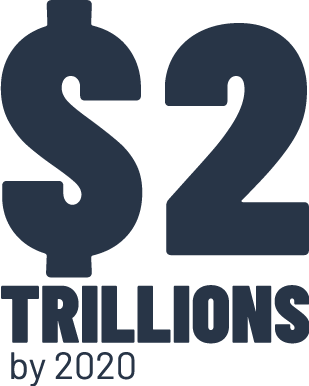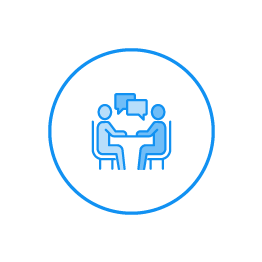Still haven’t digitized your public affairs and government relations? If the bastion of conservatism that is the UK government can do it, then why not your organization?
The UK government is not the only public entity that has realized the extent to which digitizing processes can save time and money – and help to improve quality of life for communities. The McKinsey Center for Government estimated in 2013 that government digitization could generate over $1 trillion annually worldwide.
It’s results like these that are driving the digitization trend that’s also sweeping the business world.
What does digital by default mean for governments?
The idea behind digital by default is to create online options for accessing services that make them more convenient and practical for most users than offline options (in person, by mail or phone, etc.).
The goal is not to replace offline services with digital-only options, but rather to encourage those who can turn to digital to do so. Good digital by default design aims to make online options as attractive and accessible to as many people as possible.
Scoring efficiency gains
through digital by default
The leading maxim of the digitization trend is “smaller, faster, cheaper”. So the main reason for digitizing any process should be to make it more efficient – both for the service provider as well as for the service user.
In the UK, the government’s Digital Strategy seems to be delivering on that promise. A reported 82 percent of the one million people applying to register to vote from June-August 2014 did so online rather than on paper. The government also reports a 90 percent satisfaction rate with the online service, which it predicts will produce roughly £1.7 billion in savings each year.
When designed well, digitization should inevitably lead to higher user satisfaction rates, since most individuals and businesses now prefer digital over regular in-person services.
Learn how to build a stakeholder engagement plan that will help your team build trust with key stakeholders.
Digital first for business
Few, if any, governments are subject to the same level of competitive pressure that compels . And yet, not all businesses are diving head-first toward becoming more digitally capable. The bad news for those who delay embracing a digital first culture is that they are quickly falling behind.
“There is a widening gap between leaders and laggards, with significant implications for those organizations that cannot make the transition to a digital-native organization,”
Shawn Fitzgerald, Research Director for IDC's Worldwide Digital Transformation Strategies practice in an article in Tech Republic.

According to International Data Corporation, businesses worldwide will be investing nearly $2 trillion on digital transformation by 2022 – primarily in technologies such as mobility, data, and cloud computing. By 2020, more than half of them are expected to implement an organization-wide digitization strategy
Why digitization is a top-down transition
In any organization, culture always bleeds down. To create the sweeping changes that a digital first culture often entails, CEOs and other upper management may need to open their minds to new ideas and processes.
They will also need to be ambassadors for change throughout the company. That’s important because – as we all know – change doesn’t always come easy. One reports that half of all employees fear change when digital initiatives are introduced.
One key to easing such fears is being clear about what your expectations are and what you hope to achieve. Focusing on how the changes will benefit not just the business – but the employee’s day-to-day as well – will empower teams to embrace change rather than run away from it.

Scoring early wins by starting small
Case in point: Public Affairs and Government Relations
Even businesses that are not quite ready to implement a digital first culture across the entire organization can still make massive leaps in the right direction by digitizing certain areas or departments. relations is just one example.
At a very minimum, digitizing processes, such as adopting an information management system will enable public affairs and government relations teams to:
- Centralize all data
- Analyze the information collected
- Identify material issues
- Identify key stakeholders, detractors and
- Maintain up-to-date communication records
- Prepare compliance reports
- Build a powerful corporate memory
Digitizing such processes will make teams more efficient at managing complex and ever-evolving relationships, and thereby better support local and global priorities.
Throughout the years, we have carefully considered the valuable feedback and requirements shared by our clientele. As a result, we have developed the US Elected Officials Database, a specialized resource designed specifically for American businesses. This comprehensive database alleviates the need for businesses to continually update their contact information for elected officials. By utilizing this reliable source, businesses can confidently access the most current details regarding their stakeholders. The US Elected Officials Database can help you engage more effectively to build stronger relationships with government officials and drive positive outcomes for your organization.
See how Boréalis Stakeholder Engagement for Public Affairs and Government relations can help your team influence regulations, policies and discussions that matter to your organization, customers and communities.
Streamlining digitization
According to McKinsey, most companies embarking on digital transformation underestimate how long it takes to build capabilities. This roadblock can be overcome to varying degrees by relying on existing expertise and technologies.
Teams lacking internal know-how can turn to an external partner to help clarify their current pain points, identify the problems they need to solve, and assess their digital competency to pinpoint any lacking skill sets.
Embracing digitization may initially seem like a lot of effort, but the results will be well worth it.
Sources:
- “Disruptive technologies: Advances that will transform life, business, and the global economy”, McKinsey Global Institute, May 2013. https://www.mckinsey.com/business-functions/digital-mckinsey/our-insights/disruptive-technologies
- Aamer Baig, Andre Dua, and Vivian Riefberg, “Putting citizens first: How to improve citizens’ experience and satisfaction with government services,” November 2014, McKinsey.com. https://www.mckinsey.com/~/media/mckinsey/industries/public%20sector/our%20insights/how%20us%20state%20governments%20can%20improve%20customer%20service/putting%20citizens%20first%20how%20to%20improve%20citizens%20experience%20and%20satisfaction%20with%20government%20services.ashx
- Tom Wakelin, “Creating the right company culture for digital transformation”, October 2017, Microsoft Industry Blog – United Kingdom https://cloudblogs.microsoft.com/industry-blog/en-gb/financial-services/2017/10/31/creating-the-right-company-culture-for-digital-transformation/
- “Creating a culture of digital transformation”. Microsoft. 2017. https://info.microsoft.com/rs/157-GQE-382/images/digital_spreads_00950_MICROSOFT_DT%20Report_A4_COVER.PDF
- “Digital transformation spending to hit $1.7T by 2019”. November 1, 2017. https://www.techrepublic.com/article/report-digital-transformation-spending-to-hit-1-7t-by-2019/






